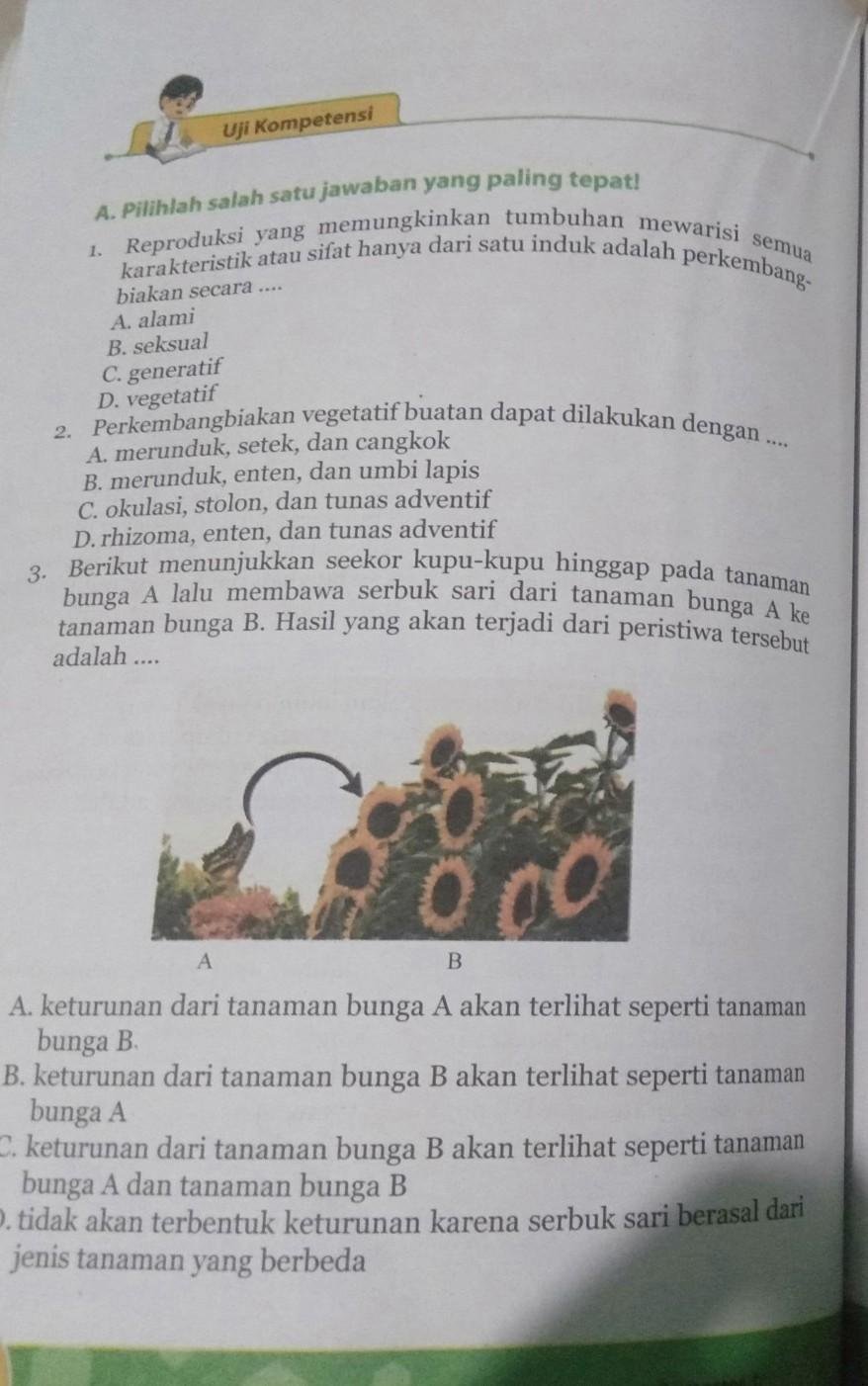
Reproduksi yang memungkinkan tumbuhan mewarisi semua karakteristik atau sifat hanya dari satu induk is known as asexual reproduction. This fascinating process allows plants to create clones of themselves, ensuring that their unique traits are passed down without variation. In a world where genetic diversity is often celebrated, asexual reproduction stands out as a method that maintains the purity of specific characteristics.
Exploring this topic reveals how nature cleverly employs this technique, allowing certain species to thrive in specific environments by relying on their well-adapted traits. Join us as we delve into the intricacies of this remarkable reproductive strategy and its implications for plant life.
Reproduksi yang Memungkinkan Tumbuhan Mewarisi Semua Karakteristik atau Sifat Hanya dari Satu Induk
In the world of plants, reproduction plays a crucial role in their survival and evolution. Among the various methods of reproduction, one particularly fascinating way allows plants to inherit all characteristics or traits from just one parent. This process, known as asexual reproduction or vegetative propagation, offers many benefits and opportunities for plant growth.
Understanding Asexual Reproduction in Plants
Asexual reproduction occurs when a single parent plant produces offspring without the involvement of gametes (sex cells). This method allows the new plants, called clones, to inherit identical genetic material from the parent. Some common types of asexual reproduction include:
- Stolon Formation: Some plants, like strawberries, produce runners or stolons that grow along the ground. These stolons develop roots and shoots, forming new plants.
- Rhizomes: Certain plants, such as ginger, reproduce through underground stems called rhizomes. These structures can sprout new shoots, leading to new plants appearing above ground.
- Tubers: Potatoes are well-known examples of plants that reproduce asexually through tubers. Each tuber can develop into a new plant when planted in the soil.
- Cuttings: Gardeners often use cuttings from a parent plant to grow new plants. A cutting may include a stem or leaf that, when placed in soil or water, can grow roots and develop into a new plant.
Advantages of Asexual Reproduction
There are several advantages to asexual reproduction that make it a favorable choice for many plants:
Genetic Uniformity
– All offspring are clones of the parent, which ensures that desirable traits are passed down consistently.
– This consistency allows gardeners and farmers to cultivate plants with specific qualities, such as faster growth or better yields.
Rapid Reproduction
– Asexual reproduction typically allows plants to reproduce faster than sexual reproduction.
– For instance, a single strawberry plant can produce numerous runners in a single growing season.
Survival in Adverse Conditions
– Asexual reproduction enables plants to thrive in environments where pollinators are scarce.
– Plants can quickly establish populations in suitable habitats without waiting for the lengthy process of flowering and pollination.
The Role of Vegetative Propagation
Vegetative propagation is a key method of asexual reproduction that involves the growth of new plants from specific parts of the parent plant. Understanding this process provides insight into how plants can pass on their traits effectively.
Types of Vegetative Propagation
Vegetative propagation occurs through various means, including:
- Layering: In this method, the parent plant bends down, and part of it stays in contact with the soil while still attached to the parent. The buried section can grow roots and eventually become a new plant.
- Division: Some plants, like perennials, can be divided into sections. Each section, with roots and shoots, can grow into a new plant when separated from the original.
- Grafting: This method involves joining two different plants to grow as one. A part of the desired plant called the scion is attached to the rootstock, which can help combine the best traits of both plants.
Examples of Asexual Reproduction in Nature
Several plants utilize asexual reproduction naturally, showcasing its effectiveness in maintaining and propagating traits.
Strawberries
Strawberries produce runners that extend out from the main plant. These runners develop roots at nodes along their length, forming new strawberry plants. This allows strawberry growers to easily propagate the species and maintain plant quality.
Potatoes
Potatoes grow tubers underground, each containing energy reserves. When conditions are right, these tubers sprout shoots, forming new plants. This method allows farmers to produce large quantities of potatoes from just a few parent plants.
Bamboo
Bamboo can reproduce through rhizomes that spread horizontally underground, allowing the plant to cover large areas quickly. This capability helps bamboo survive in various environments while maintaining its strong, desirable characteristics.
Importance of Asexual Reproduction in Agriculture
Asexual reproduction provides several benefits that can enhance agricultural practices.
Consistency and Quality Control
– Farmers can clone specific plants with desirable traits, ensuring the quality and consistency of their crops.
– This practice helps in meeting market demands and consumer preferences.
Cost-Effectiveness
– Asexual reproduction reduces the need to buy new seeds or plants each season, saving money for farmers.
– For perennial crops, this method maximizes the return on investment from the original planting.
Adaptation to Environment
– Asexually produced plants can be selected for specific environmental conditions, leading to improved resilience and productivity in challenging climates.
– Farmers can cultivate varieties that thrive in local conditions, enhancing food security.
Challenges of Asexual Reproduction
While asexual reproduction has many advantages, it also presents certain challenges that need to be addressed.
Lack of Genetic Diversity
– Cloning can lead to a lack of genetic diversity, making plants susceptible to diseases and pests.
– The entire population may be at risk if a disease affects the parent plant.
Overcrowding
– Rapid propagation can lead to overcrowded conditions, competing for resources like light, water, and nutrients.
– Gardeners must manage spacing to allow individual plants to thrive.
Limited Adaptability
– Clones may lack the ability to adapt to changing environmental conditions since they share the same genetic makeup.
– If conditions change drastically, the entire population may struggle to survive.
Future of Asexual Reproduction in Plant Science
The field of plant science continues to explore ways to enhance asexual reproduction. Innovations in technology and methods can potentially improve crop production and sustainability.
Biotechnology Advances
– Research in plant tissue culture allows scientists to produce clones under controlled conditions.
– This technology can help maintain the health of plants while producing large quantities of genetically identical specimens.
Genetic Engineering
– Genetic engineering may allow for the introduction of beneficial traits into asexually reproduced plants.
– This approach can address issues of disease resistance and environmental adaptability while maintaining the benefits of asexual reproduction.
Integration with Sustainable Practices
– Combining asexual reproduction with sustainable farming methods can lead to healthier ecosystems.
– Practices like permaculture and agroforestry can enhance biodiversity while utilizing asexual reproduction techniques.
Asexual reproduction remains a vital aspect of plant life, allowing for the efficient transfer of traits and characteristics from one parent plant to offspring. By utilizing methods like vegetative propagation, plants can thrive in various conditions, providing food and resources for humans and ecosystems alike. Understanding this process helps us appreciate the complexity and resilience of plant life, ensuring that we can continue to cultivate and protect our plant species for generations to come.
Jawaban PG Uji Kompetensi Bab 2 IPA Kelas 9 Halaman 120
Frequently Asked Questions
What is the main advantage of asexual reproduction in plants?
Asexual reproduction allows plants to reproduce quickly and efficiently without the need for a mate. This process leads to offspring that are genetically identical to the parent, ensuring that successful traits are preserved and passed on. It enables plants to colonize areas rapidly, which is particularly beneficial in stable environments where adaptations to change are not necessary.
How does asexual reproduction impact genetic diversity?
Asexual reproduction generally leads to lower genetic diversity among a population of plants. Since all offspring are clones of the parent, they share the same genetic material. While this can be advantageous in stable environments, it may also make the plants more vulnerable to diseases and environmental changes due to their lack of genetic variation.
Can you provide examples of asexual reproduction methods in plants?
Common methods of asexual reproduction in plants include vegetative propagation, such as the use of tubers, bulbs, and runners. For instance, strawberries reproduce through runners that sprout new plants, while potatoes grow from tubers that develop into new plants. Additionally, certain plants can regenerate from cuttings, where a fragment of the parent plant develops roots and grows independently.
What role do conditions play in the success of asexual reproduction?
Environmental conditions significantly influence the success of asexual reproduction in plants. Factors such as soil quality, water availability, and climate can affect the growth and development of new plants. Favorable conditions can enhance the propagation rate, while adverse conditions may hinder growth and lead to lower survival rates of the new plants.
How does asexual reproduction affect agricultural practices?
Asexual reproduction plays a crucial role in agriculture by allowing farmers to produce large quantities of uniform crops. Techniques such as cloning and grafting enable the propagation of high-yield, disease-resistant varieties. This method ensures consistency in crop quality and facilitates the cultivation of plants adapted to specific environmental conditions.
Final Thoughts
Reproduksi yang memungkinkan tumbuhan mewarisi semua karakteristik atau sifat hanya dari satu induk memberi kesempatan bagi spesies untuk mempertahankan sifat-sifat unggul mereka. Metode ini memastikan konsistensi dalam kualitas tanaman, mengurangi variabilitas yang sering terjadi dalam reproduksi seksual. Dengan mengandalkan satu induk, petani dan peneliti dapat menghasilkan produk yang lebih dapat diandalkan dan berkualitas tinggi. Pendekatan ini sangat berharga dalam pertanian dan penelitian botani untuk mengembangkan varietas unggul yang sesuai dengan kebutuhan pasar.




